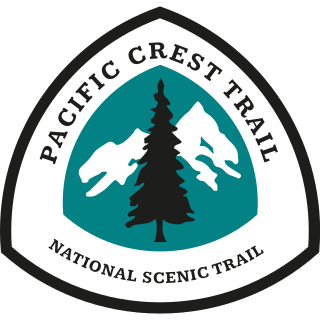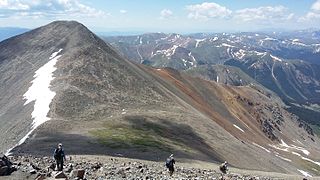
The Appalachian Trail, is a hiking trail in the Eastern United States, extending almost 2,200 miles (3,540 km) between Springer Mountain in Georgia and Mount Katahdin in Maine, and passing through 14 states. The Appalachian Trail Conservancy claims the Appalachian Trail to be the longest hiking-only trail in the world. More than three million people hike segments of the trail each year.

Hiking is a long, vigorous walk, usually on trails or footpaths in the countryside. Walking for pleasure developed in Europe during the eighteenth century. Religious pilgrimages have existed much longer but they involve walking long distances for a spiritual purpose associated with specific religions.

The Pacific Crest Trail (PCT), officially designated as the Pacific Crest National Scenic Trail, is a long-distance hiking and equestrian trail closely aligned with the highest portion of the Cascade and Sierra Nevada mountain ranges, which lie 100 to 150 miles east of the U.S. Pacific coast. The trail's southern terminus is next to the Mexico–United States border, just south of Campo, California, and its northern terminus is on the Canada–US border, upon which it continues unofficially to the Windy Joe Trail within Manning Park in British Columbia; it passes through the states of California, Oregon, and Washington.

The Continental Divide National Scenic Trail is a United States National Scenic Trail with a length measured by the Continental Divide Trail Coalition of 3,028 miles (4,873 km) between the U.S. border with Chihuahua, Mexico and the border with Alberta, Canada. Frequent route changes and a large number of alternate routes result in an actual hiking distance of 2,700 miles (4,300 km) to 3,150 miles (5,070 km). The CDT follows the Continental Divide of the Americas along the Rocky Mountains and traverses five U.S. states — Montana, Idaho, Wyoming, Colorado, and New Mexico. In Montana near the Canadian border the trail crosses Triple Divide Pass.

The John Muir Trail (JMT) is a long-distance trail in the Sierra Nevada mountain range of California, passing through Yosemite, Kings Canyon and Sequoia National Parks. From the northern terminus at Happy Isles in Yosemite Valley and the southern terminus located on the summit of Mount Whitney, the trail's length is 213.7 miles (343.9 km), with a total elevation gain of approximately 47,000 feet (14,000 m). For almost all of its length, the trail is in the High Sierra backcountry and wilderness areas. For about 160 miles (260 km), the trail follows the same footpath as the longer Pacific Crest Trail. It is named after John Muir, a naturalist.
Earl V. Shaffer, was an American outdoorsman and author known from 1948 as The Crazy One for attempting what became the first publicized claimed hiking trip in a single season over the entire length of the Appalachian Trail (AT). He also worked as a carpenter, a soldier specializing in radar and radio installation, and an antique dealer.

Emma Rowena (Caldwell) Gatewood, known as Grandma Gatewood,, was an American ultra-light hiking pioneer. After a difficult life as a farm wife, mother of eleven children, and survivor of domestic violence, she became famous as the first solo female thru-hiker of the 2,168-mile (3,489 km) Appalachian Trail (A.T.) in 1955 at the age of 67. She subsequently became the first person to hike the A.T. three times, after completing a second thru-hike two years later, followed by a section-hike in 1964. In the meantime, she hiked 2,000 miles (3,200 km) of the Oregon Trail in 1959. In her later years, she continued to travel and hike, and worked on a section of what would become the Buckeye Trail. The media coverage surrounding her feats was credited for generating interest in maintaining the A.T. and in hiking generally. Among many other honors, she was posthumously inducted into the Appalachian Trail Hall of Fame in 2012.

Ultralight backpacking is a subset of lightweight backpacking, a style of backpacking which emphasizes carrying the lightest and least amount of gear. While no technical standards exist, some hikers consider "ultralight" to mean an initial base weight of less than 4.5 kg (9.9 lb). Base weight is the weight of a fully loaded backpack at the start of a trip, excluding worn weight and consumables such as food, water, and fuel. Base weight can be lowered by reducing the weight of individual items of gear, or by choosing not to carry that gear. Ultralight backpacking is most popular among thru-hikers.

Brian Robinson is a competitive distance hiker and long-distance runner, holding multiple world-firsts and ultramarathon world records. Robinson was the first person to hike the Triple Crown of Hiking in one year, a total distance of over 7,000 miles.
Scott Williamson is an American thru-hiker, most noted for being the first person to complete a continuous one-season round trip of the Pacific Crest Trail (PCT). He is also noted for his speed records for hiking the PCT.

The Triple Crown of Hiking informally refers to the three major U.S. long-distance hiking trails:

The Appalachian Trail Museum is located in Pine Grove Furnace State Park near Gardners, Pennsylvania, United States, and commemorates the builders, maintainers and hikers of the Appalachian Trail, including those in the Appalachian Trail Hall of Fame. Features include a 1959 trail shelter from Peters Mountain built by Earl Shaffer, the first A.T. thru-hiker, vintage hiking and trail building equipment, historic A.T. signs, A.T. displays on permanent loan from the Smithsonian Institution, a recreation of A.T. founder Benton MacKaye's Sky Parlor office and a display on the National Trails System Act of 1968. The Museum also has an extensive research library.

Francis Tapon is an author, global nomad, and public speaker. He has walked across the United States four times via its three major mountain ranges. He also walked across Spain twice. He was the first person to do a round-trip backpacking the Continental Divide Trail. In addition, he thru-hiked the Pacific Crest Trail and Appalachian Trail southbound. He has traveled to over 100 countries of the world. Lastly, he is the author of the self-help travelogue Hike Your Own Hike and the travel narrative The Hidden Europe: What Eastern Europeans Can Teach Us. He traveled to all 54 African countries from 2013 to 2018 and climbed to the highest point of 50 of those countries. In 2019, he was inducted into the California Outdoors Hall of Fame.
The Great Western Loop is a 6,875 miles (11,064 km) long hiking route that passes through several states of the western United States.
The Appalachian Long Distance Hikers Association or ALDHA-East is a non-profit organization founded in 1983 to support and promote the interests of Appalachian Trail long-distance hikers. It "was the first organization of long-distance hikers in the United States".

The Tahoe–Yosemite Trail (TYT) is a long-distance trail in the Sierra Nevada mountain range of California. The trail courses 186 miles (299 km) from Meeks Bay at Lake Tahoe to Tuolumne Meadows in Yosemite National Park. The trail is a foot and equestrian path that passes through the Desolation, Mokelumne, Carson-Iceberg, Emigrant, and Yosemite Wilderness Areas and the Meiss Country (Dardanelles) Roadless Area.
Elizabeth Thomas is a thru-hiking champion and former women's unassisted speed record holder for the 2,181-mile (3,510 km) Appalachian Trail. She holds the hiking "Triple Crown," having completed the Appalachian Trail, Pacific Crest Trail, and the Continental Divide Trail. She is the pioneer of the Chinook Trail in Washington and the Wasatch Range in Utah. She is Vice President of the American Long Distance Hiking Association-West, an ambassador for the American Hiking Society, and an outdoors writer for Wirecutter, a New York Times publication. She is also Editor-in-Chief of Treeline Review, a hiking gear publication. As of 2018, she completed 20 long-distance wilderness hikes.
Jennifer Mabus is an American YouTuber and hiker. She spent 173 days thru-hiking the Pacific Crest Trail solo in 2018, filming every day of the journey, and posting vlogs to her YouTube channel covering every day of the journey as she hiked. She competed collegiately in cheerleading for the Nevada Wolf Pack.
Bart Smith is an outdoor photographer who concentrates on documenting America's National Trails System. Over the course of more than 25 years, he became the first person to hike and photograph all of the 11 national scenic trails and to traverse all of the 19 national historic trails. The 30 national trails go through all 50 states, with a total mileage of more than 50,000 miles.

The Continental Divide Trail Coalition (CDTC) is a Colorado-based organization that works to complete, promote, and protect the Continental Divide National Scenic Trail. The CDT is used by hikers, equestrians, and mountain bikers, and runs approximately 3,000-miles along the Continental Divide from Mexico to Canada. The trail crosses five states: New Mexico, Colorado, Wyoming, Idaho, and Montana, and is considered one of the three Triple Crown of Hiking trails in the United States.













